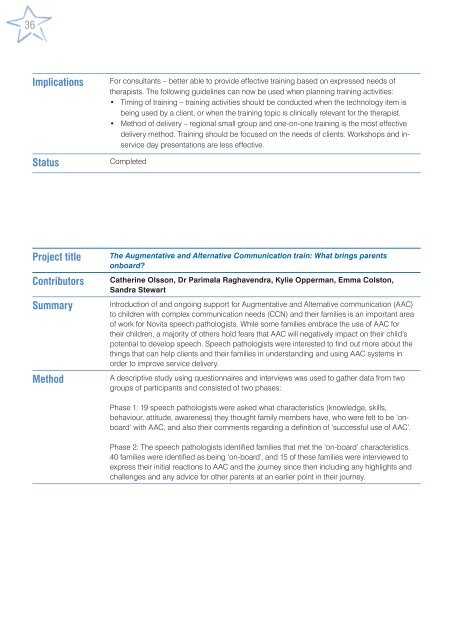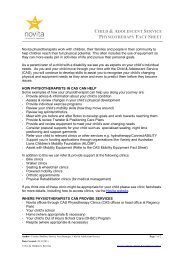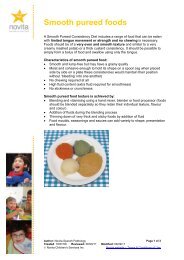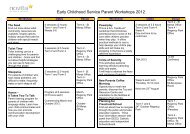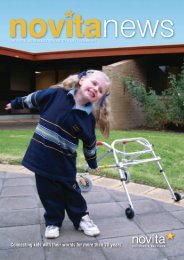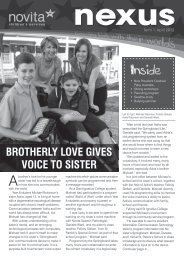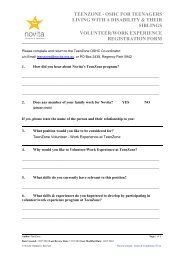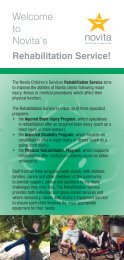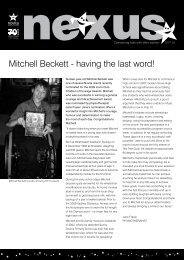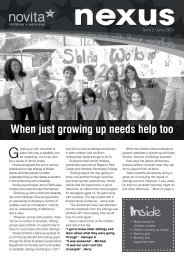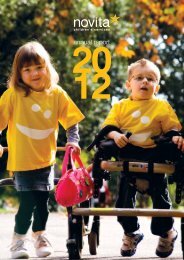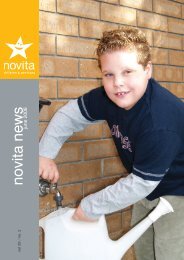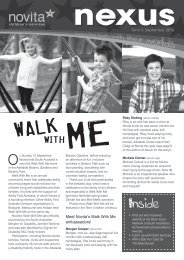Novita Research Report - 2004 to 2007 - Novita Children's Services
Novita Research Report - 2004 to 2007 - Novita Children's Services
Novita Research Report - 2004 to 2007 - Novita Children's Services
- No tags were found...
You also want an ePaper? Increase the reach of your titles
YUMPU automatically turns print PDFs into web optimized ePapers that Google loves.
36ImplicationsStatusFor consultants – better able <strong>to</strong> provide effective training based on expressed needs oftherapists. The following guidelines can now be used when planning training activities:• Timing of training – training activities should be conducted when the technology item isbeing used by a client, or when the training <strong>to</strong>pic is clinically relevant for the therapist.• Method of delivery – regional small group and one-on-one training is the most effectivedelivery method. Training should be focused on the needs of clients. Workshops and inserviceday presentations are less effective.CompletedProject titleContribu<strong>to</strong>rsSummaryMethodThe Augmentative and Alternative Communication train: What brings parentsonboard?Catherine Olsson, Dr Parimala Raghavendra, Kylie Opperman, Emma Cols<strong>to</strong>n,Sandra StewartIntroduction of and ongoing support for Augmentative and Alternative communication (AAC)<strong>to</strong> children with complex communication needs (CCN) and their families is an important areaof work for <strong>Novita</strong> speech pathologists. While some families embrace the use of AAC fortheir children, a majority of others hold fears that AAC will negatively impact on their child’spotential <strong>to</strong> develop speech. Speech pathologists were interested <strong>to</strong> find out more about thethings that can help clients and their families in understanding and using AAC systems inorder <strong>to</strong> improve service delivery.A descriptive study using questionnaires and interviews was used <strong>to</strong> gather data from twogroups of participants and consisted of two phases:Phase 1: 19 speech pathologists were asked what characteristics (knowledge, skills,behaviour, attitude, awareness) they thought family members have, who were felt <strong>to</strong> be ‘onboard’with AAC, and also their comments regarding a definition of ‘successful use of AAC’.Phase 2: The speech pathologists identified families that met the ‘on-board’ characteristics.40 families were identified as being ‘on-board’, and 15 of these families were interviewed <strong>to</strong>express their initial reactions <strong>to</strong> AAC and the journey since then including any highlights andchallenges and any advice for other parents at an earlier point in their journey.


